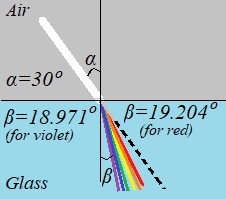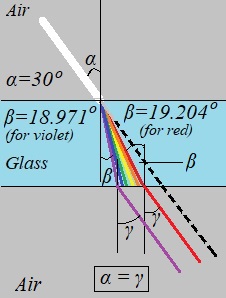Dispersion on Flat Surface
Let's talk about rainbow.
Everybody saw it, it's beautiful, but what is the reason for rainbow to appear after rain or above the waterfall?
A short answer is - refraction.
As we know, when the light goes through a border between two different transparent substances, it deviates from the original direction (unless it hits the border perpendicularly to its surface).
The angle of refraction (an angle between an outgoing ray of light and a normal to a border surface) is related to an incident angle (an angle between an incoming ray of light and a normal to a border surface), according to the Law of Refraction, as:
sin(θ1)/sin(θ2) = V1/V2
where
θ1 is an incident angle
θ2 is a refraction angle
V1 is a speed of an incident ray of light (depends on the substance where the incoming ray propagates)
V2 is a speed of a refracted ray of light (depends on the substance where the outgoing ray propagates)
Instead of a speed of light in a particular substance, we can use the refractive index n of this substance, which is a ratio of the speed of light in vacuum c to a speed of light in this substance V:
n = c/V
Then the Law of Refraction would look like
sin(θ1)/sin(θ2) = n2 /n1
or
sin(θ1)·n1 = sin(θ2)·n2
As we see, the relationship between angles of incident and refraction depends on the speeds of light propagation in two bordering substances.
At this point it's important to notice from the equation above that, if the light moves from a substance, where it is faster, into a substance, where it is slower, that is n1 is less than n2 (like from the air into the glass) then the angle of incident must be greater than the angle of refraction.
Similarly, if the light moves from a substance, where it is slower, into a substance, where it is faster, that is n1 is greater than n2 (like from the glass into the air) then the angle of incident must be smaller than the angle of refraction.
Now we know that the visible white light is a combination of lights of different colors and wavelengths, with the longest wavelength being for red light and the shortest - for violet.
What's extremely important to understand is that the speed of propagation in vacuum for lights of all wave lengths (that is, of all colors) is the same c, but, as soon as the light ray goes inside some substance, like glass or water, or even air, the speed of lights of different wavelengths (that is, of different colors) is different. The red light with the longest wavelength in the visible spectrum propagates faster than violet (the shortest length in the visible spectrum) with all intermediary light colors propagating within the interval between these two speeds.
Since refractive index of any substance depends on the speed of light propagation inside this substance, the refractive index depends on what color of light we use to measure the angle of refraction. For practical purposes, talking about refractive index of any substance without referencing a particular color, the yellow light is used, because yellow is somewhere in the middle between the fastest in the visible spectrum red color and the slowest violet.
Taking into consideration different speeds of different light colors, using the refractive index n=c/V as a measure of speed propagation in the glass, its value for red light is, approximately, 1.520, that is the red light in the glass is in 1.520 times slower than speed of light in the vacuum. The same glass' refractive index for violet light is, approximately, 1.538.
Here is a full table of glass refractive indices n for different visible colors (that is, different wavelengths λ in nanometers (nm)):
| Color | Wave λ | Refract n | Red | 660 | 1.520 | Orange | 610 | 1.522 | Yellow | 580 | 1.523 | Green | 550 | 1.526 | Blue | 470 | 1.531 | Violet | 410 | 1.538 |
Assume, for example, that the white light comes from the air onto a glass surface at the incident angle α=30°. This means that all color components of this white light are parallel to each other and each has exactly the same incident angle α=30°.
The air refractive index nair is, approximately, 1.000 for all colors, while the refractive index of the glass nglass is more significantly different for different colors, as represented in the table above.
Let's find the refraction angles β of different colors inside the glass using the Law of Refraction
sin(α)·nair = sin(β)·nglass,
from which we can find
sin(β) = sin(α)·nair /nglass
β = arcsin[sin(α)·nair /nglass]
Since sin(α)=sin(30°)=0.5 and nair=1.000, trivial calculations result in the following refraction angles for different colors, if the incident angle is 30° for each:
| Color | α | n | β | Red | 30° | 1.520 | 19.205° | Orange | 30° | 1.522 | 19.179° | Yellow | 30° | 1.523 | 19.166° | Green | 30° | 1.526 | 19.126° | Blue | 30° | 1.531 | 19.062° | Violet | 30° | 1.538 | 18.971° |
As you see, the angles of refraction are different for different colors, which causes the corresponding rays of different colors to differently deviate from the original direction of the white light. This angular deviation is called dispersion.
Picture below schematically represents the dispersion of the white light into its color components on the border between the air and the glass. All these color components deviate from the original direction of the white light (dotted line on the picture) by different deviation angle Δ=α−β.

Let's consider now what happens with a ray of white light when it passes through a window glass at some incident angle α. What's important is that the light undergoes two refractions, first going from the air into the glass, then from the glass into the air.
The picture below represents this process.

The refraction angle from the passing the top border from the air to the glass β will be an incident angle for the bottom border between the glass and the air, and the angle γ will be the refraction angle for the rays coming out from the glass into the air.
According to the Law of Refraction, the angle of incident β and angle of refraction γ are related as
sin(β)·nglass = sin(γ)·nair
Comparing this formula with the one for the top surface of the glass
sin(α)·nair = sin(β)·nglass,
we conclude that α = γ
The last equality, basically, states that all outgoing rays of different colors are parallel to the original incoming white light ray, but are at some distance from it caused by refraction, and this difference is different for different colors; the closest to original direction of the incoming white light after double refraction on two glass surfaces is the red component, and the farthest is the violet one.
We do not usually see much of a dispersion on window glass because the glass is relatively thin, so the component rays of different colors are not significantly deviated from the original direction after the first refraction, and after the second refraction they can mix together forming white light again. The only visible separation of colors can be observed when a relatively narrow ray of white light falls at an angle on a thick glass, which would allow the colors to visibly separate from each other, especially at the edges of the narrow white ray of light.
If the glass thickness is h, the maximum angle of refraction for red color is βmax and the minimum angle of refraction for violet color is βmin, the distance between outgoing parallel red and violet rays will be
h·[tan(βmax)−tan(βmin)]·cos(α)
Simple calculations for the glass of 2.5 mm thickness show that the white light coming at the incident angle of 30° will be split into different colors in such a way that the distance between outgoing parallel red and violet rays will be only


No comments:
Post a Comment